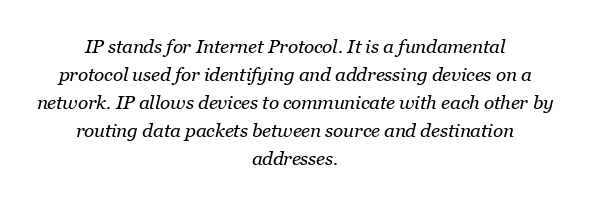
What is IP Called?
IP stands for Internet Protocol, a fundamental communication protocol in the TCP/IP suite used for relaying packets of data across network boundaries. It is primarily responsible for addressing, routing, and delivering packets from the source host to the destination host based on their IP addresses.
IP is a network layer protocol, categorized as Layer 3 in the OSI (Open Systems Interconnection) model. It defines how data should be packetized, addressed, transmitted, routed, and received at the destination.
Functions of IP
IP plays several critical roles in network communication:
- Addressing: Every device connected to an IP network is assigned a unique IP address. This address identifies the device and the network it belongs to.
- Packetization: Data is broken down into smaller units known as packets, which are encapsulated in IP headers for identification and routing.
- Routing: IP defines how packets should be forwarded from one router to another until they reach their destination.
- Fragmentation and Reassembly: If a data packet is too large for transmission over the network, IP handles breaking it into fragments and reassembling them at the destination.
IP Versions
There are two main versions of the Internet Protocol in widespread use today:
| Version | Description |
|---|---|
| IPv4 | Uses 32-bit addresses, allowing for approximately 4.3 billion unique addresses. Still widely used across the Internet. |
| IPv6 | Uses 128-bit addresses, allowing for a virtually unlimited number of unique IP addresses. Designed to overcome IPv4 exhaustion. |
IPv4 addresses are typically written in dotted-decimal notation (e.g., 192.168.1.1), whereas IPv6 addresses use hexadecimal and colons (e.g., 2001:0db8:85a3::8a2e:0370:7334).
Types of IP Addresses
IP addresses can be categorized based on usage:
- Public IP: Assigned by ISPs, these addresses are globally unique and can be reached over the Internet.
- Private IP: Reserved for internal network use (e.g., 192.168.0.0/16), not routable on the public Internet.
- Static IP: Permanently assigned to a device, ensuring it always has the same IP address.
- Dynamic IP: Temporarily assigned by DHCP servers and may change over time.
IP Protocol in the TCP/IP Stack
In the TCP/IP model, the Internet Protocol is part of the Internet Layer. It works alongside other protocols to ensure end-to-end communication:
- TCP (Transmission Control Protocol): Ensures reliable delivery with error checking and retransmission.
- UDP (User Datagram Protocol): Provides a connectionless mode of communication with lower overhead.
- ICMP (Internet Control Message Protocol): Used for diagnostics and error reporting (e.g., ping).
What Is an IP Packet?
An IP packet consists of two main parts:
- Header: Contains metadata including source IP address, destination IP address, version, TTL (Time to Live), and more.
- Payload: The actual data being transported, such as an email, web request, or file data.
The header ensures that routers and receiving hosts can process and deliver the packet correctly.
IP Address Classes (for IPv4)
In early implementations, IPv4 was divided into classes to structure address allocation:
| Class | Range | Purpose |
|---|---|---|
| Class A | 1.0.0.0 – 126.0.0.0 | Large networks |
| Class B | 128.0.0.0 – 191.255.0.0 | Medium networks |
| Class C | 192.0.0.0 – 223.255.255.0 | Small networks |
| Class D | 224.0.0.0 – 239.255.255.255 | Multicast |
| Class E | 240.0.0.0 – 255.255.255.255 | Reserved |
Although this class-based system is largely obsolete, it still appears in legacy configurations and discussions.
Use Cases of IP
Internet Protocol is used in nearly all forms of network communication, including:
- Web browsing
- Email exchange
- Voice over IP (VoIP)
- File transfer (FTP, SFTP)
- Streaming media
- Cloud services
Every action on the Internet, from loading a webpage to sending a message, relies on the functioning of IP to deliver data to the correct location.
In essence, IP is the backbone of all modern networking systems, providing a standardized way for devices to communicate over vast distances using a common addressing framework.